(Upload on December 20 2025) [ 日本語 | English ]
Mount Usu / Sarobetsu post-mined peatland
From left: Crater basin in 1986 and 2006. Cottongrass / Daylily
HOME > Lecture catalog / Research summary > Glossary > Mycology
[fungi, mycorrhiza, saprophytic plant, fungal taxonomy, lichens, references]
|
myco = fungus (Greek) + logy = logic (Greek) Formerly, mycology is one of the subjects in botany.
taxonomy About 100,000 named species and perhaps more than 200,000 unnamed species
|
Sporocarps (胞子嚢果): micro-or macroscopicc and showing limited tissue differentiation Habitat (生息地): ubiquitous as saprobes, symbionts, parasites, or hyperparasites Distribution (分布): cosmopolitan |
Hypha (菌糸, pl. phyphae)a long, branching, filamentous structure of a fungus, oomycete, or actinobacterium→ the main mode of vegetative growth for most fungi Mycelium (菌糸体, pl. mycelia)root-like structure of a fungus consisting of a mass of branching, thread-like hyphae |
Life cycle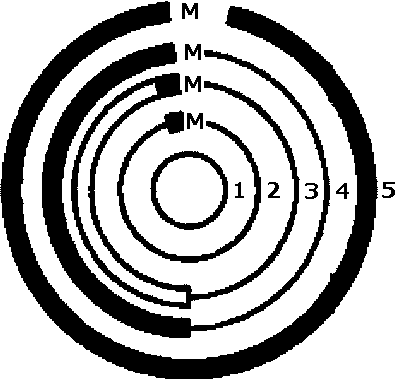 Fig. Fungal life cycles. Each circle represents a life cycle and should be read clockwise; M, meiosis; single line, haploid phase; double line, dikaryotic phase; solid line, diploid phase. The three principal life cycles are as follows; 1, asexual; 2, haploid (common in Ascomycotina); 3, haploid dikaryotic (many Ascomycotina have a brief dikaryotic phase but a long dikaryotic phase is typical of Basidiomycotina); 4, haploid-diploid (unusual in fungi but occurs in some Chytridiomycotina); 5, diploid (characteristic of the Straminipila, only very rarely in Eumycota). (Burnett 1975)
Fig. Fungal life cycles. Each circle represents a life cycle and should be read clockwise; M, meiosis; single line, haploid phase; double line, dikaryotic phase; solid line, diploid phase. The three principal life cycles are as follows; 1, asexual; 2, haploid (common in Ascomycotina); 3, haploid dikaryotic (many Ascomycotina have a brief dikaryotic phase but a long dikaryotic phase is typical of Basidiomycotina); 4, haploid-diploid (unusual in fungi but occurs in some Chytridiomycotina); 5, diploid (characteristic of the Straminipila, only very rarely in Eumycota). (Burnett 1975)
|
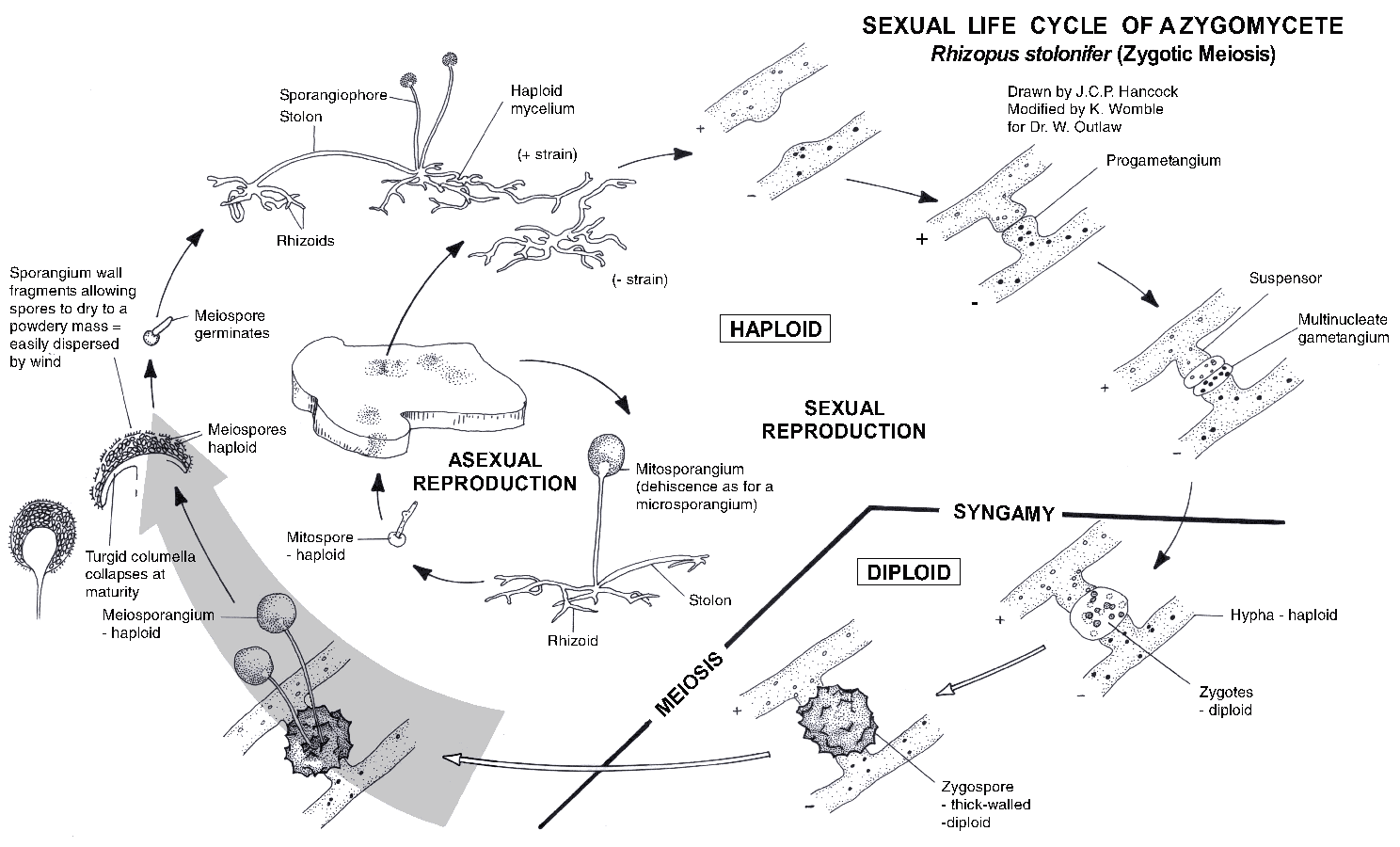 Zygomycete |
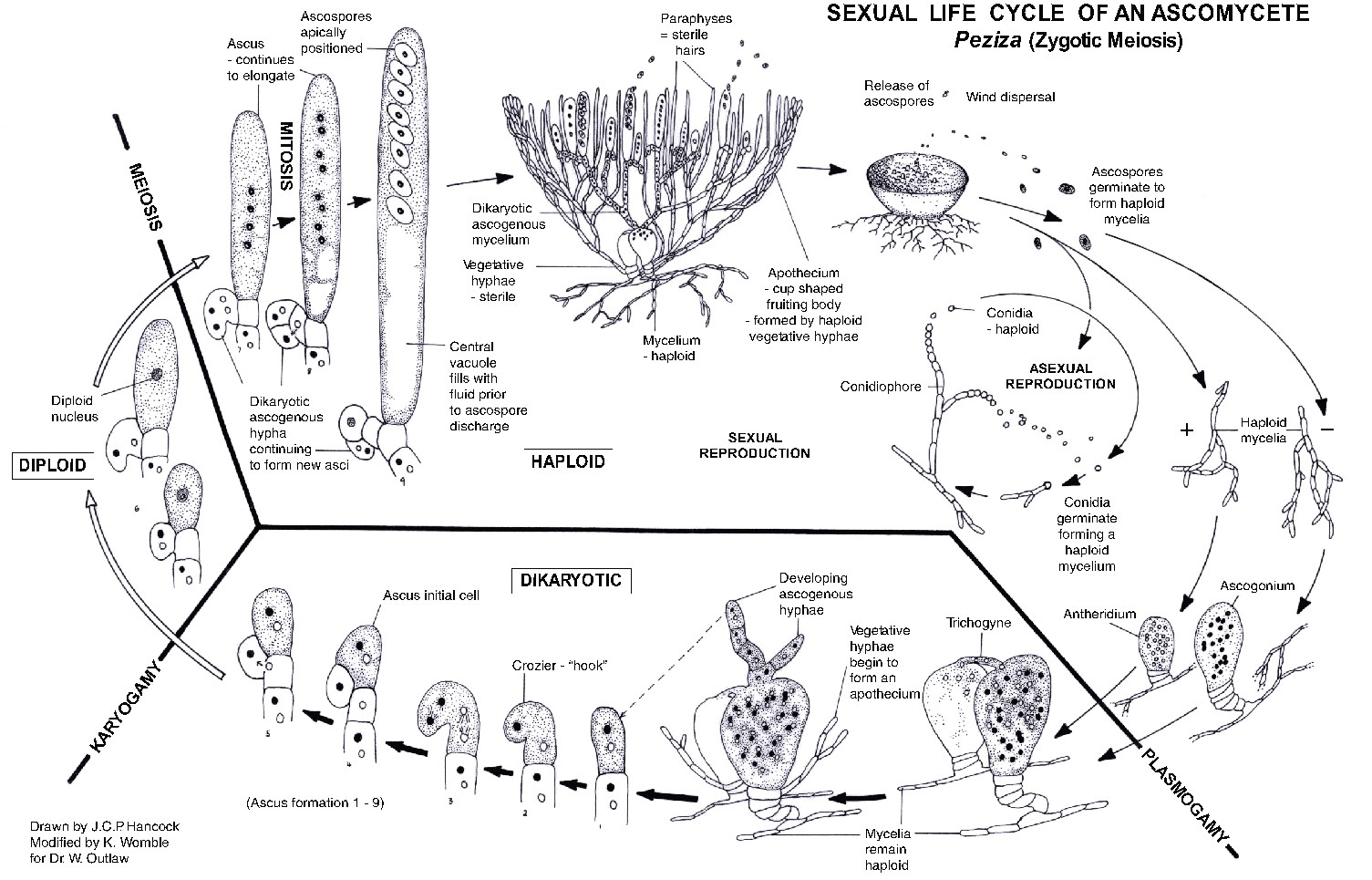 Ascomycete |
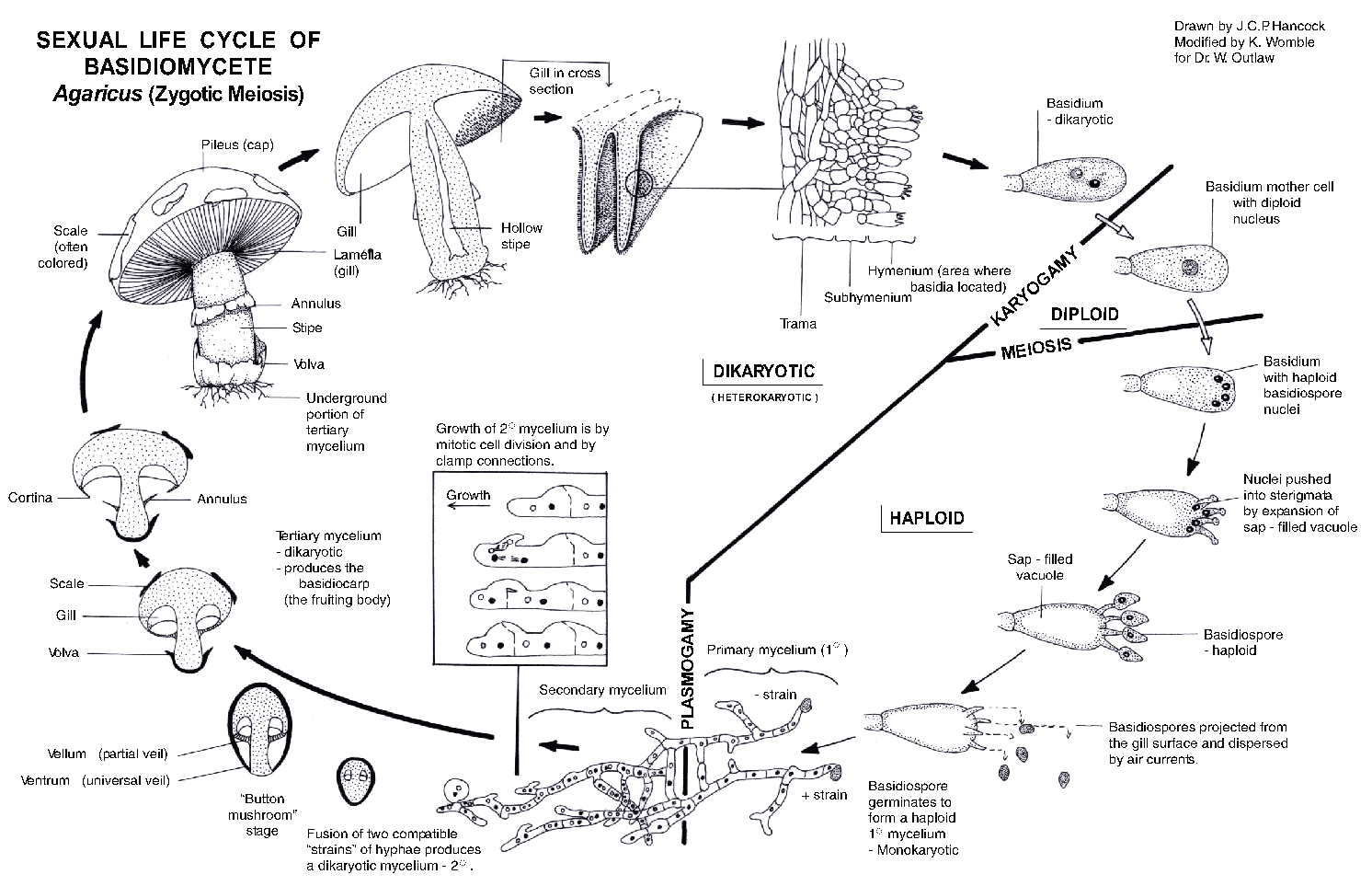 Basidiomycete |
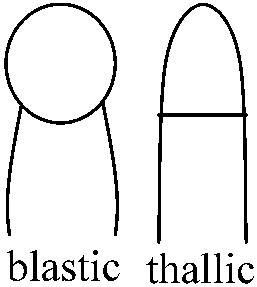
Perfect and imperfect statesConidium (pl. conidia, 分生子)Blastic: holoblastic, enteroblasticThallic: holothallic, holoarthric, enteroarthric |
| adnate 沿着の |
Def. multicellular reproductive structure that produces and disperses spores, often visible as mushrooms, puffballs or similar forms0) Growth mode6) Skirt (鍔) (Left to right) pendant, flaring, sheathing, double, clbwebby, ring zone |
8) Spore print (胞子紋) Diagrams of gill characters, as shown by the lower surface of the pileus 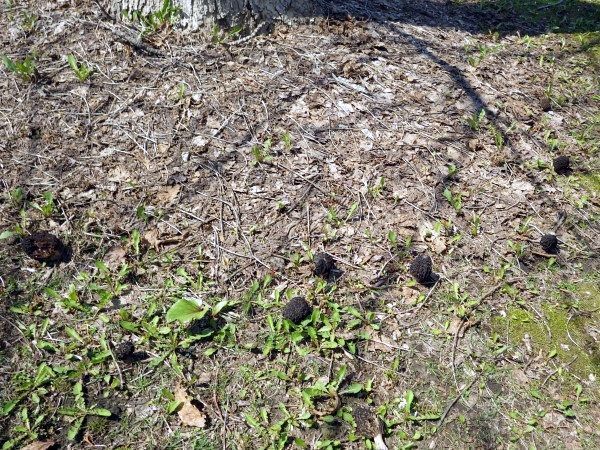 Fairy ring, fairy circle, elf circle or pixie ring (菌輪): occurring ring or arc of mushrooms
Fairy ring, fairy circle, elf circle or pixie ring (菌輪): occurring ring or arc of mushrooms
tethered type: mycorrhizal fungi living in symbiosis with trees |
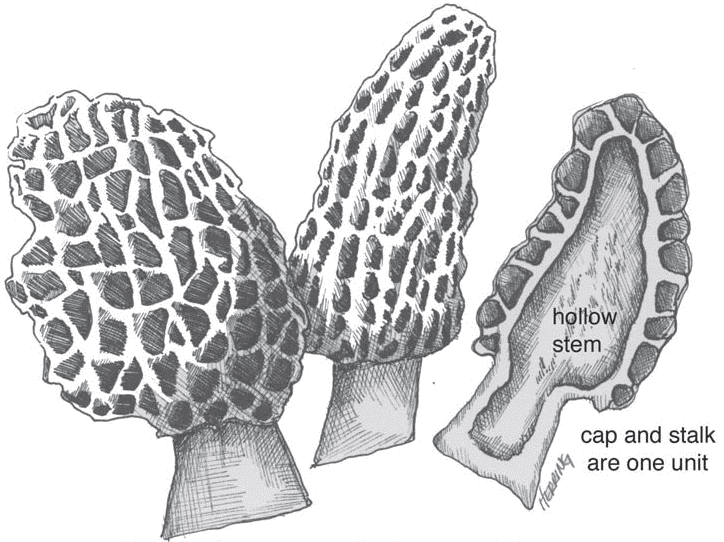 1
1
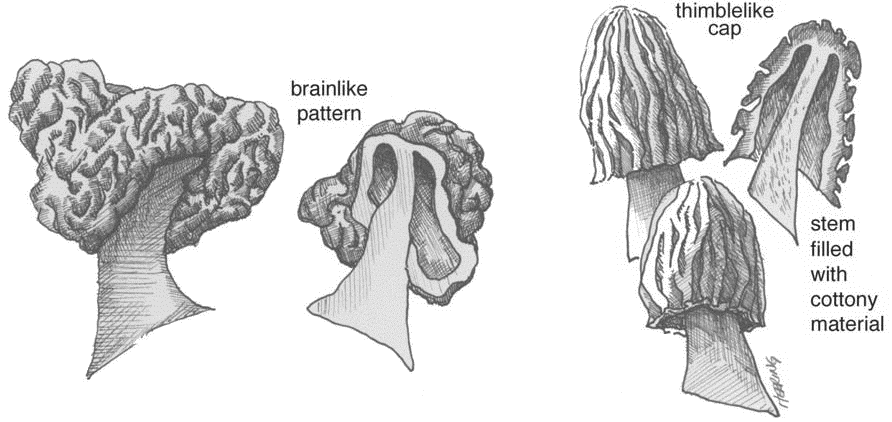 2
2
[1] Edible and choice Morchella spp. (morels) [2] Do not eat Gyromitra esculenta (left) and Verpa boheica (right). Morels are common in Alaska soon after wildfires (森林火災). (Morchella f<g Gr植物名morchelから。ノボリリョウ科)
| Yeast groupu (family) | Subfamily | Representative genera |
| Ascosporogenous yeast 有子嚢胞子酵母 (Endomycetaceae) |
Schizosaccharomycetoideae Saccharomycetoideae Nematosporoideae |
Schizosaccharomyces, Endomycopsis Saccharomyces, Pichia, Debaryomyces, Hansenula, Nadsonia Nematospora, Lipomyces |
| Sporobolomycetous yeast スポロボロミセス酵母 (Sporobolomycetaceae) | Sporobolomyces, Bullera | |
| Asporogenous yeast 無胞子酵母 (Cryptococcaceae) | Cryptococcoideae Trichosporodideae Rhodotoruloideae | Cryptococcus, Torulopsis, Candida, Trigonopsis Trichosporon Rhodotorula |
Succession of fungi (遷移)Primary and secondary sereCoprophilous fungi (糞生菌)Parasitic fungi (寄生菌)Materials for parasiteAnimal: entomogenous, predacious, mycoses Plant: parasitic fungi
Ex. Peronosporaceae (露菌): obligate parasites on plants Ex. Tolypocladium capitatum (タンポタケ), (T. ophioglossoides (ハナヤスリタケ), Nyctalis lycoperdoides = Asterophora lycoperdoides (ヤグラタケ) Mycotoxins (菌類有毒物質)naturally occurring toxic compounds produced by fungi
Ex. immune suppression, liver and kidney damage, cancer Toxic mushroom (毒キノコ)fungi that contain harmful compounds capable of causing illness or death when ingested
≈ 3% of known mushroom species are toxic Phytopathology (植物病理学)Plant disease: damages (= diseases) due to the disruption of physiological processes
Infectious diseases, derived mostly by pathogenic organism, e.g., fungus, bacterium, mycoplasma, virus, viroid, nematode, or parasitic flowering plant |
Bast (disease) or dieback (胴枯病): filamentous fungi (糸状菌)
apple, infected by Diaporthe tanakae and Phomopsis mali Powdery or white mildew (ウドンコ病)Erysiphaceae(ウドンコカビ/菌)
Grape: Erysiphe necator or Uncinula necator Pucciniales or Uredinales (サビ菌)
Pucciniaceae (柄生サビ菌): Uromyces, Gymnosporangium, Puccinia, Phragmidium
0: spermogonia (柄子) White root-rot (白紋羽病): Rosellinia necatrix Violet root-rot (紫紋羽病): Helicobasidium mompa Crown wart (こぶ病) - bacteria Soft rot (軟腐病) Erwinia aroideae, E. carotovora |
|
A symbiotic or pathogenic relationship between fungi and the vascular plant roots
Fungus kingdom: Basidiomycetes, Ascomycetes and Zygomycetes Plants give carbohydrates produced by photothynthesis to fungi
Reward: Endomycorrhiza (内生菌)the hyphae penetrating the plant cell wall and invaginate the cell membrane
Arbuscular mycorrhiza (AM, formerly VAM) Glomeromycota
Ericoid mycorrhiza Ectomycorrhiza, ECM (外生菌)the hyphae not penetrating plant cells within the root
limited to trees and shrubs Akasaka, Tsuyuzaki & Hase 2007Annual growth of invasive Larix kaempferi seedlings with reference to microhabitat and ectomycorrhiza1 colonization on a volcanoTitus JH & Tsuyuzaki S. 2002Arbuscular mycorrhizal distribution in relation to microsites on recent volcanic substrates of Mt. Koma, Hokkaido, Japan |
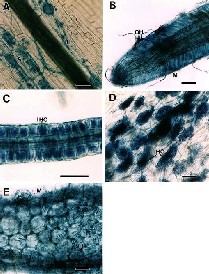 Fig. 1. Five types of mycorrhizae observed on Mount Koma in 2000. A: arbuscular mycorrhizae detected from the roots of Elaeanus pungens Thunb., B: ectomycorrhizae from the roots of Salix bakko Kimura., C: ericoid mycorrhizae from the roots of Ledum palustre L. var. diversipilosum Nakai, D: orchid mycorrhizae from Spiranthes sinensis (Pers.) Ames, and E: arbutoid mycorrhizae from Pyrola incarnata Fisch. M: mantle, H: hyphae, C: hyphal coil, V: vesicules, and A: arbuscules. OH: outer hyphae. IHC: Intracellular-hyphae-complex. No monotropoid mycorrhizae were observed in the present study. Each scale bar indicates 50 mm. (Tsuyuzaki et al. 2005)
Fig. 1. Five types of mycorrhizae observed on Mount Koma in 2000. A: arbuscular mycorrhizae detected from the roots of Elaeanus pungens Thunb., B: ectomycorrhizae from the roots of Salix bakko Kimura., C: ericoid mycorrhizae from the roots of Ledum palustre L. var. diversipilosum Nakai, D: orchid mycorrhizae from Spiranthes sinensis (Pers.) Ames, and E: arbutoid mycorrhizae from Pyrola incarnata Fisch. M: mantle, H: hyphae, C: hyphal coil, V: vesicules, and A: arbuscules. OH: outer hyphae. IHC: Intracellular-hyphae-complex. No monotropoid mycorrhizae were observed in the present study. Each scale bar indicates 50 mm. (Tsuyuzaki et al. 2005)
Isotope analysisSporocarps of mycorrhizal fungi (Hobbie et al. 2001):
3.5 ‰↓ δ13C
mycorrhizal fungi have higher δ15N |
|
= myco-heterotrophy symbiotic relationship between plants and fungi, in which the plant gets all or part of its food from parasitism on fungi rather than from photosynthesis Habitats → forests (with many exceptions) |